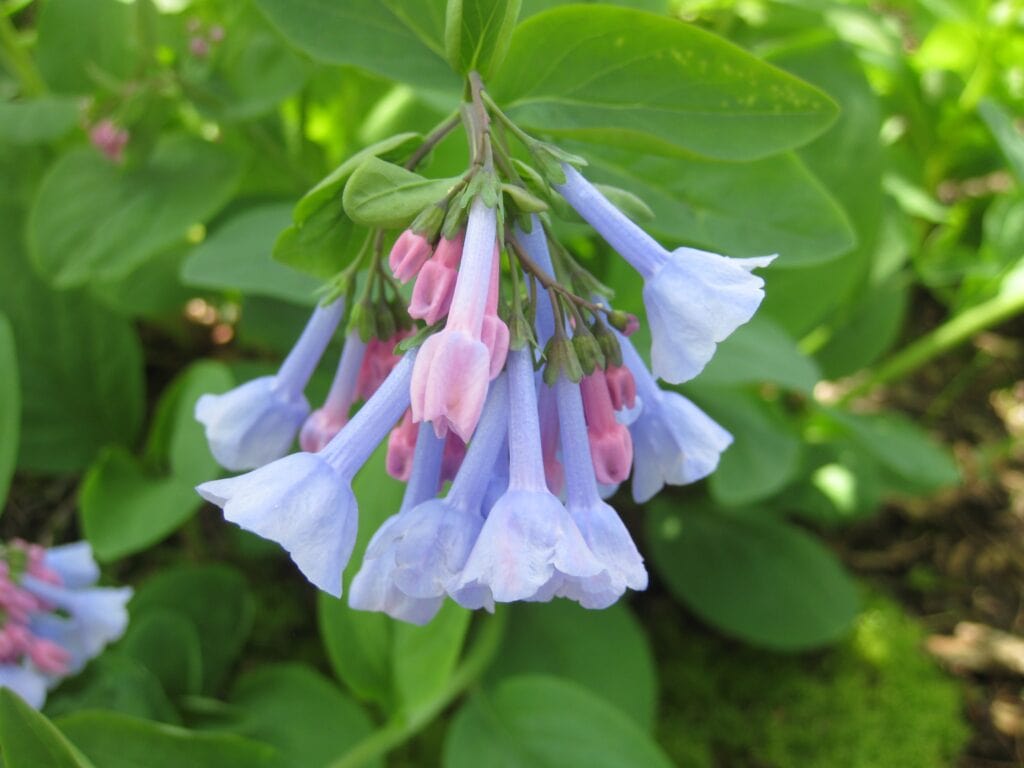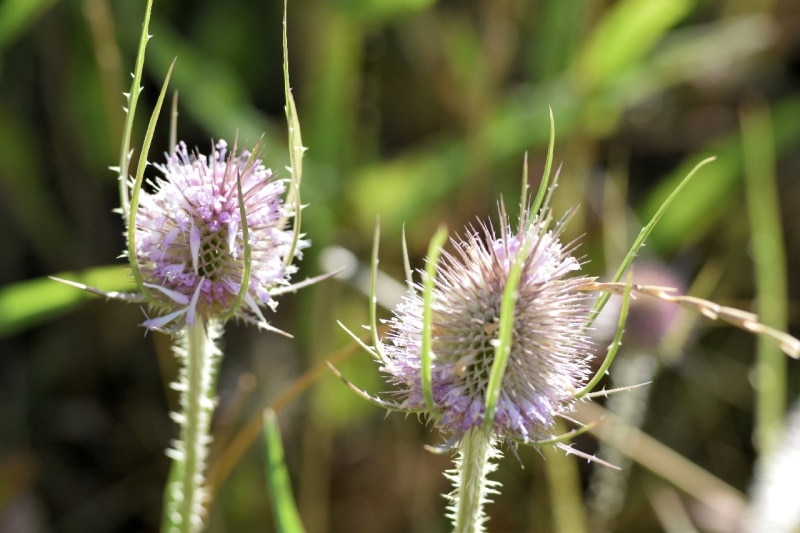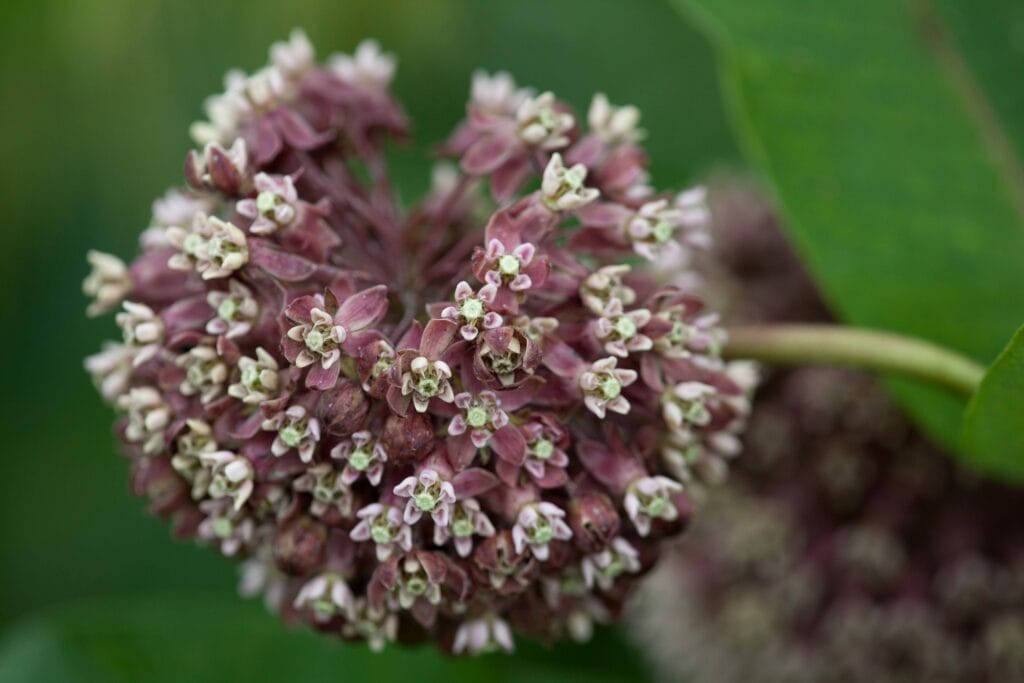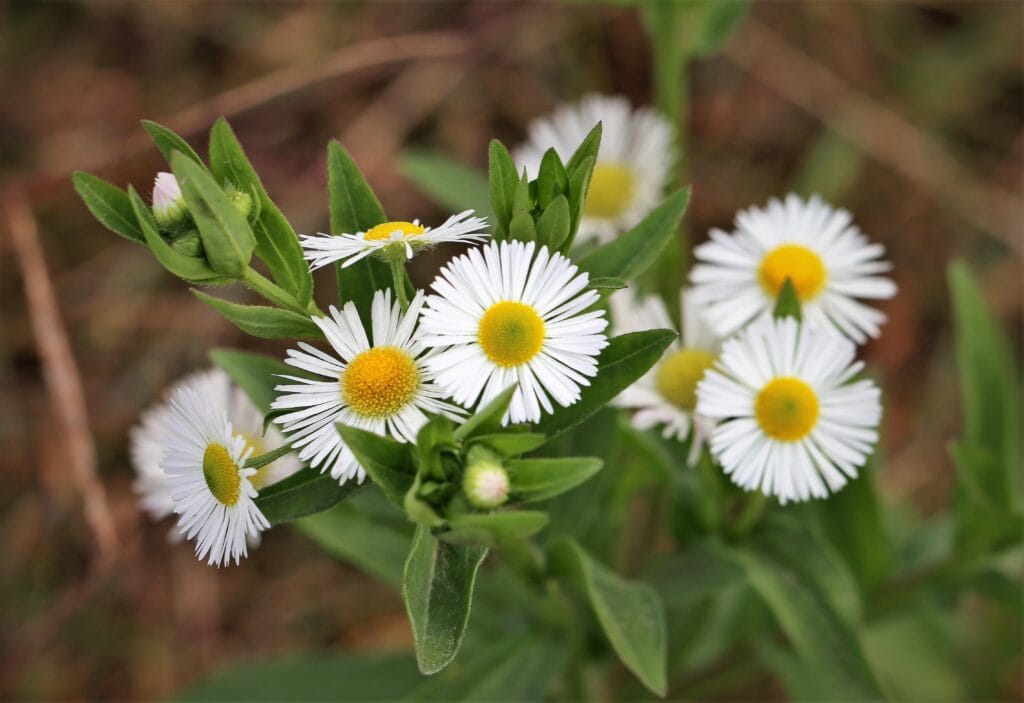63 Wildflowers That Grow in Nebraska (Identification Guide with Pictures)
-

- Last updated:
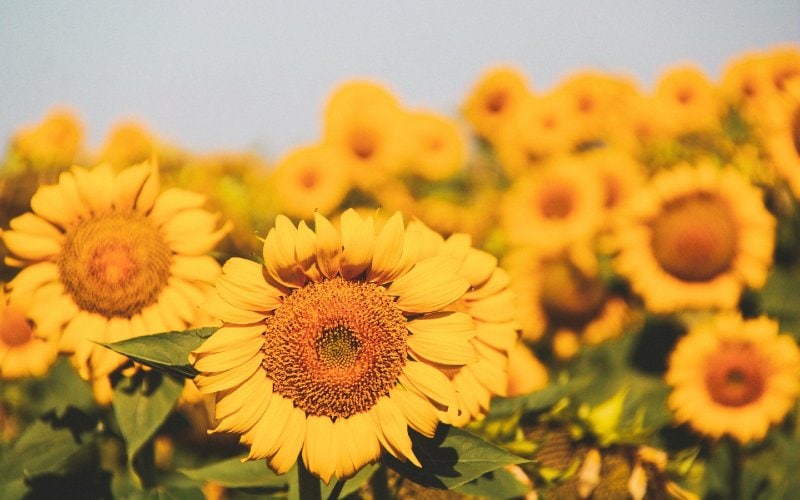
Nebraska is home to hundreds of native wildflowers, as well as a large selection of introduced and naturalized wildflowers. There are species in a gamut of colors, and whether you are looking for native plants that will attract pollinators like hummingbirds, or a plant that offers the best ground cover, there are wildflowers to meet your needs. Below are 63 wildflowers that grow in Nebraska, grouped by color.

Blue Wildflowers
1. Bachelor’s Button
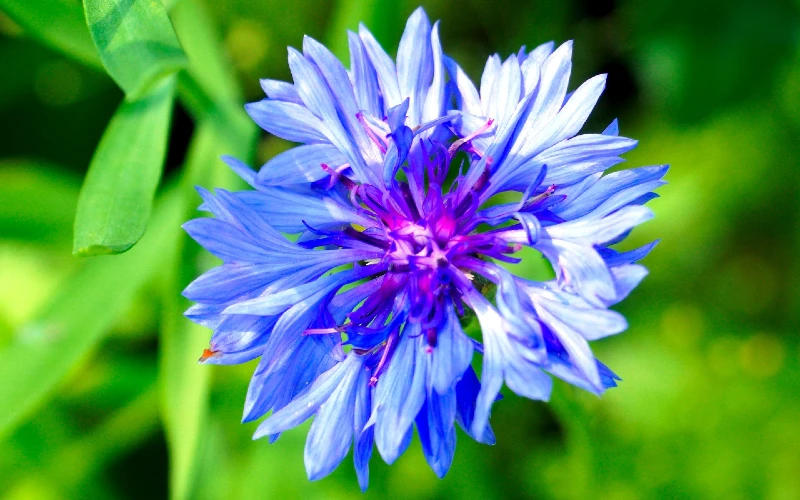
| Latin Name: | Centaurea cyanus |
Bachelor’s button is also commonly known as cornflower and is an annual flowering plant. As well as being a common wildflower, it is also grown ornamentally and is popular for cutting and drying.
2. Blue Vervain
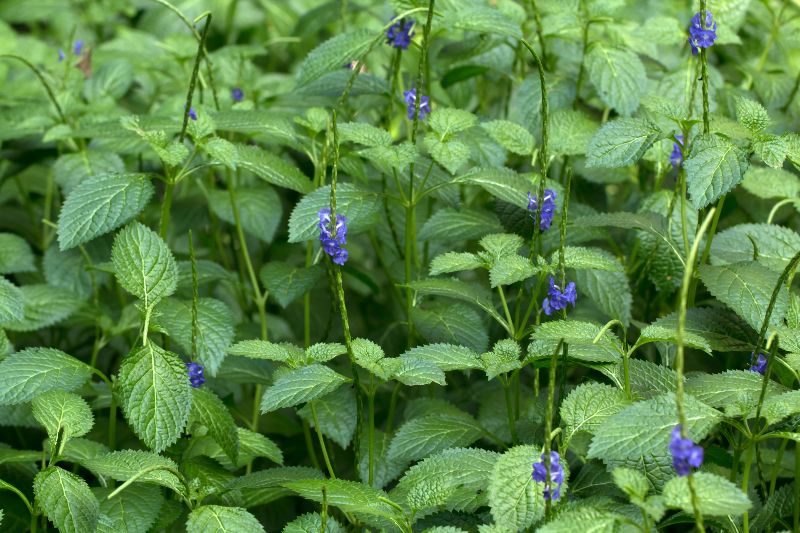
| Latin Name: | Verbena hastata |
The American vervain, or blue vervain, is a perennial that is very effective at attracting pollinators, including bees and butterflies. It is considered drought-resistant and very hardy and is found in foothills and wet soils.
3. Blue Violet
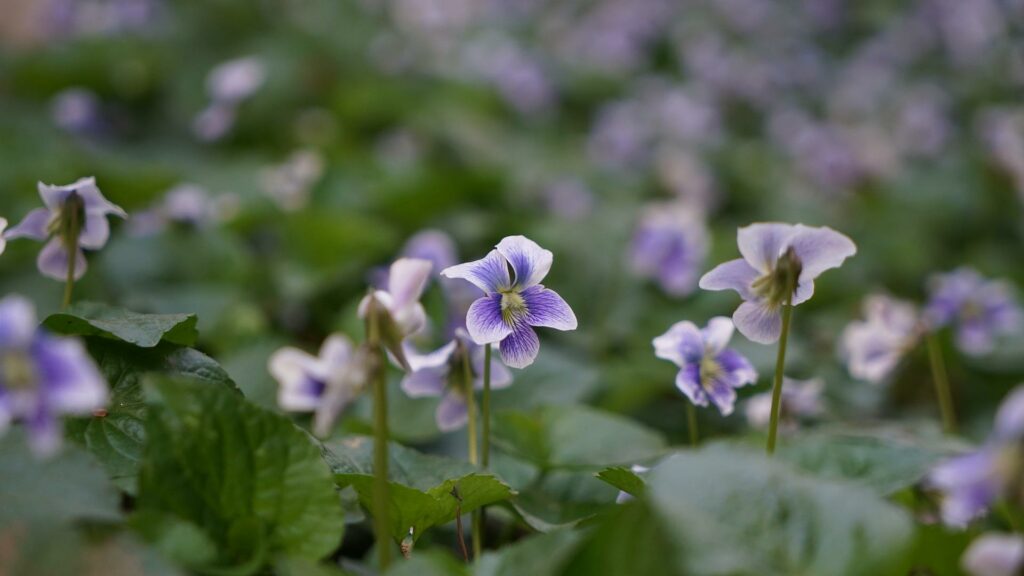
| Latin Name: | Viola sororia |
The blue-violet is a perennial plant that grows to approximately 10 inches and grows well in full sun or partial shade. Many gardeners treat it as a weed because it can spring up in the middle of a lawn. It is popular with pollinators and beneficial insects.
4. Bluebells
| Latin Name: | Mertensia virginica |
The bluebell is a common type of wildflower that blooms early in Nebraska. They can grow to 2 feet tall but typically achieve closer to 1 foot in height. They attract hummingbirds and can be found in woods or damp fields.
5. Chicory
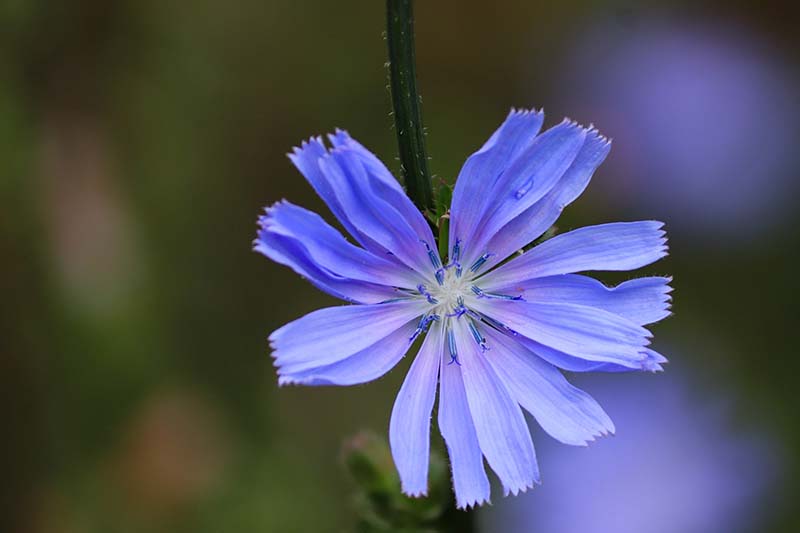
| Latin Name: | Cichorium intybus |
Chicory is a sun-loving perennial that can grow to several feet tall, and along with having pretty blue daisy-like flowers, it is edible. Chicory has long been used as a substitute for coffee and is found wild in open spaces.
6. Periwinkle

| Latin Name: | Vinca minor |
The periwinkle is a small wildflower that reaches 6 inches tall and can grow in most sun or shade conditions. Although not a native plant, the periwinkle attracts pollinators, including bees, and is resistant to deer.

Purple Wildflowers
7. Anise Hyssop
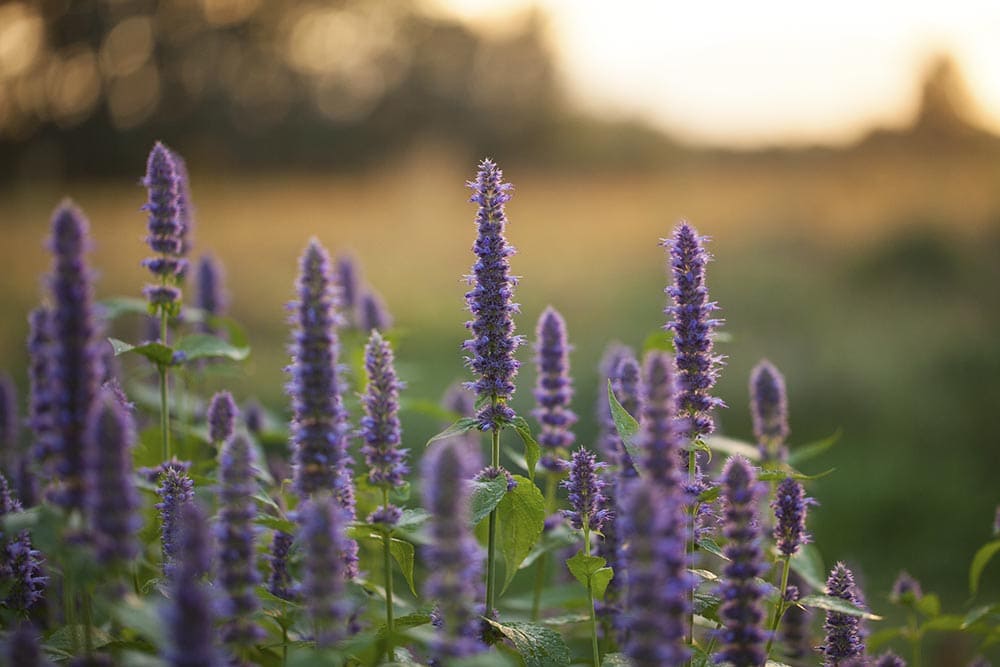
| Latin Name: | Agastache foeniculum |
Anise hyssop is a perennial plant with spikes of lavender flowers throughout summer. This is another wildflower that tends to be popular with pollinators.
8. Bee Balm
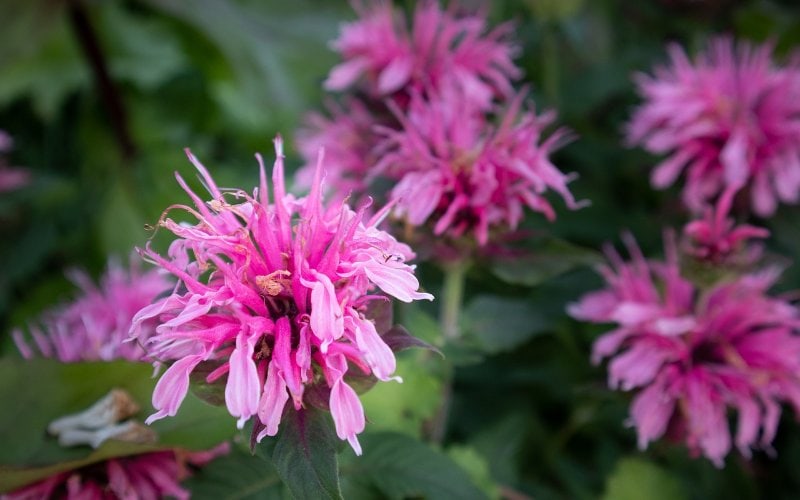
| Latin Name: | Monarda fistulosa |
Bee balm, or wild bergamot, grows to around four 4 tall and is commonly found in fields and prairies. When planted in gardens, it attracts bees and hummingbirds, and the leaves are used medicinally, especially for their antimicrobial properties.
9. Bull Thistle
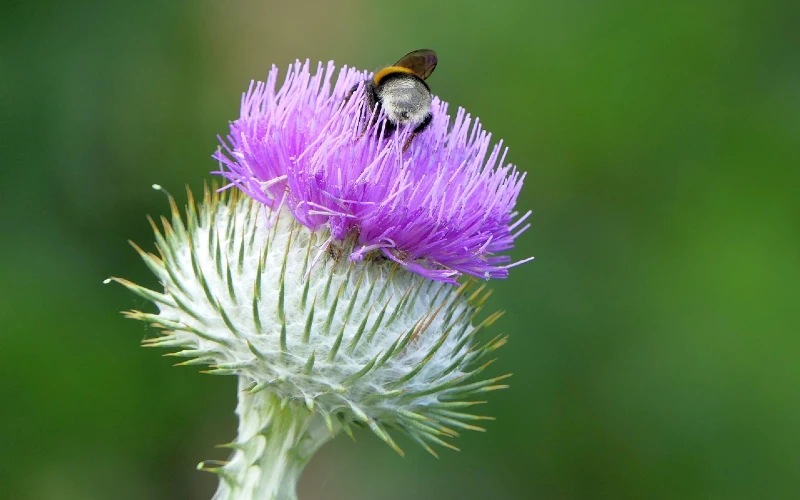
| Latin Name: | Cirsium Vulgare |
The common thistle can be found in full sun or areas with partial shade. It is a biennial that can grow to 6 feet tall. It has spines that can be sharp, and the thistle is popular with goldfinches as a food source and for nesting material.
10. Burdock
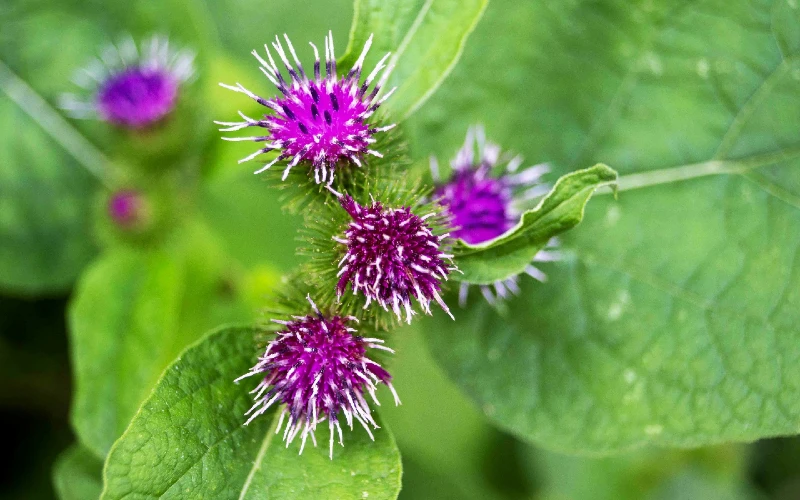
| Latin Name: | Arctium minus |
The biennial burdock can be found in fields, by the side of roads, in barnyards, and on railways. It can irritate the skin when handled, and the flower attracts birds and bees.
11. Clasping Bellflower
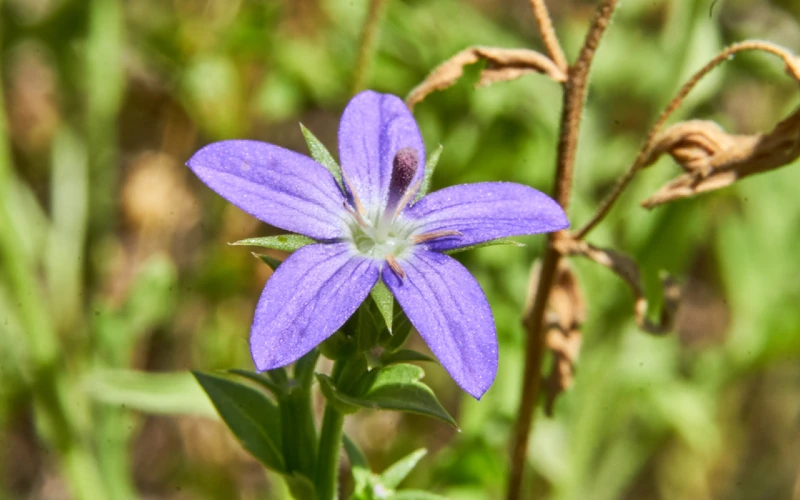
| Latin Name: | Triodanis perfoliata |
The clasping bellflower, also known as the clasping Venus, is an annual wildflower. It can grow to 3 feet tall and is commonly found in disturbed ground. The self-pollinating clasping bellflower attracts bees and butterflies.
12. Creeping Charlie
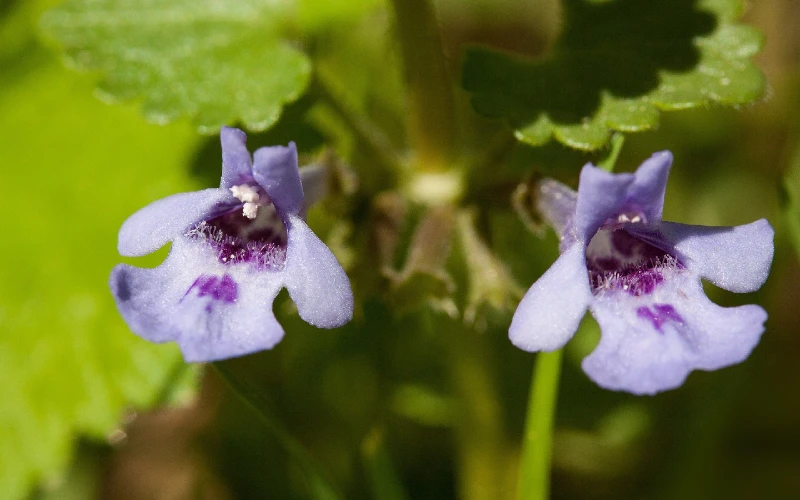
| Latin Name: | Glechoma hederacea |
Creeping Charlie is a perennial that is very popular with bees. It can achieve a height of 8 inches and grow in shade or full sun conditions. Because it is often found growing in lawns and has a challenging root system, it is usually considered a weed.
13. Dame’s Rocket
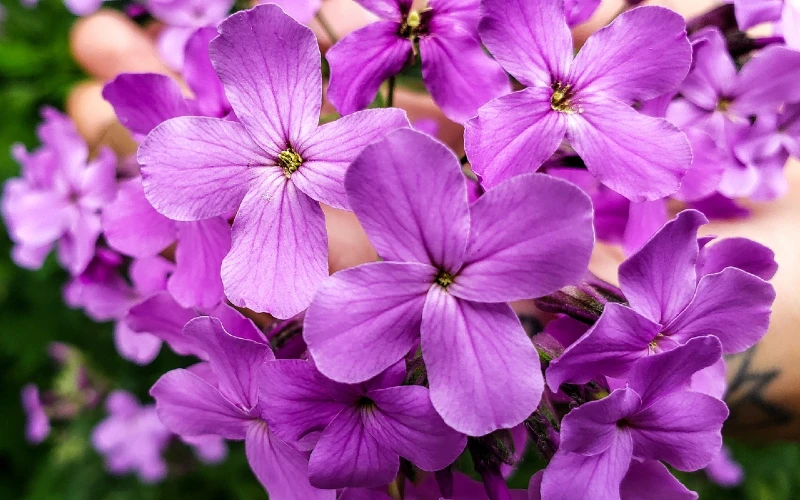
| Latin Name: | Hesperis matronalis |
Dame’s rocket goes by many names, including the summer lilac and Damask violet. It can grow to 1 foot or more and enjoys sun or partial shade, commonly seen in meadows and fields. It is a fast-spreading flower that is common in wildflower packets.
14. Giant Ironweed
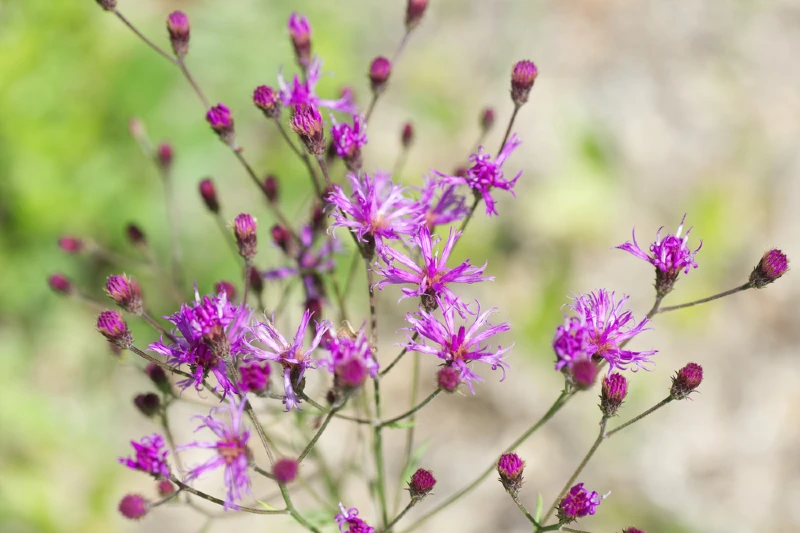
| Latin Name: | Vernonia gigantea |
Found in woodlands and meadows across Nebraska, giant ironweed can attract Monarchs, which need as much help as gardeners and growers can give them. The plants can grow to as tall as 8 feet.
15. Heal All
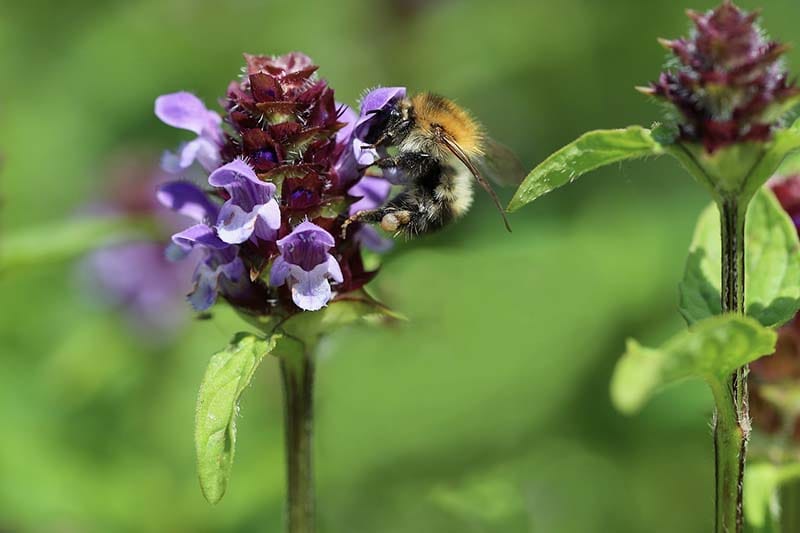
| Latin Name: | Prunella vulgaris |
The perennial heal all is not only attractive to pollinators, including butterflies and bees but is also useful for creating wild gardens. It is found in meadows and fields but can grow aggressively in lawns.
16. Lady’s Leek
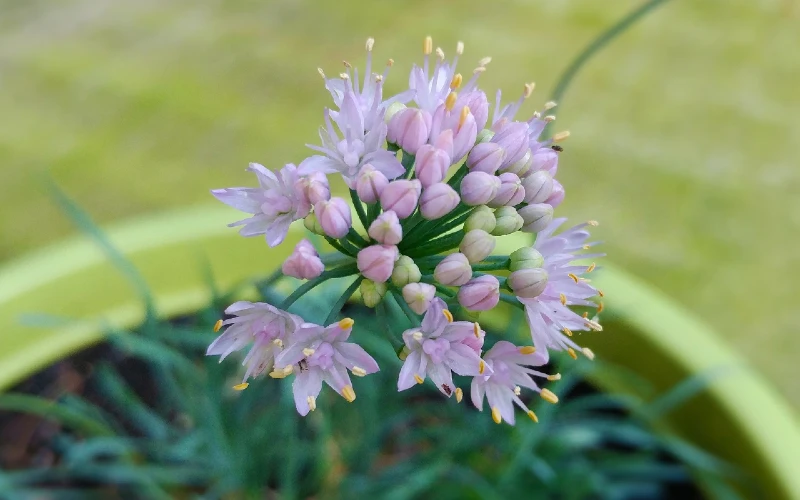
| Latin Name: | Allium cernuum |
Lady’s leek enjoys full sun or partial shade, and each stem can produce as many as 30 small purple flowers at the head. It attracts butterflies but is deer resistant and often seen in glades and open woods.
17. Purple Coneflower
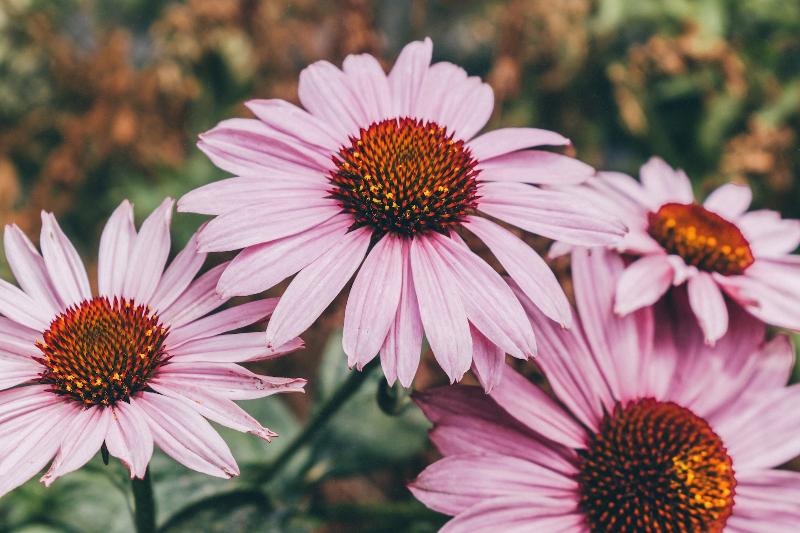
| Latin Name: | Echinacea purpurea |
The purple coneflower is a drought-resistant perennial that grows to 3 feet in height. It is a hardy flower but attracts rabbits that enjoy feasting on the leaves. Echinacea is a medicinal plant used to help stave off infections.
18. Purple Loosestrife

| Latin Name: | Lythrum salicaria |
The perennial purple loosestrife can grow to 5 feet in height and enjoys full sun. It blooms in summer, but it is an invasive species that can push native plants out of your garden.
19. Teasel
| Latin Name: | Dipsacus fullonum |
Teasel is a prickly plant and grows to 6 feet in height. Its seeds are a popular food source, and the plant has been used for its medicinal properties to help strengthen the liver and to treat broken bones and other injuries.

Pink Wildflowers
20. Common Milkweed
| Latin Name: | Asclepias syriaca |
The common milkweed flower is a summer-blooming perennial that grows best when exposed to full sun. It is very effective at attracting pollinators and can be seen in a wide variety of habitats across Nebraska.
21. Crown Vetch
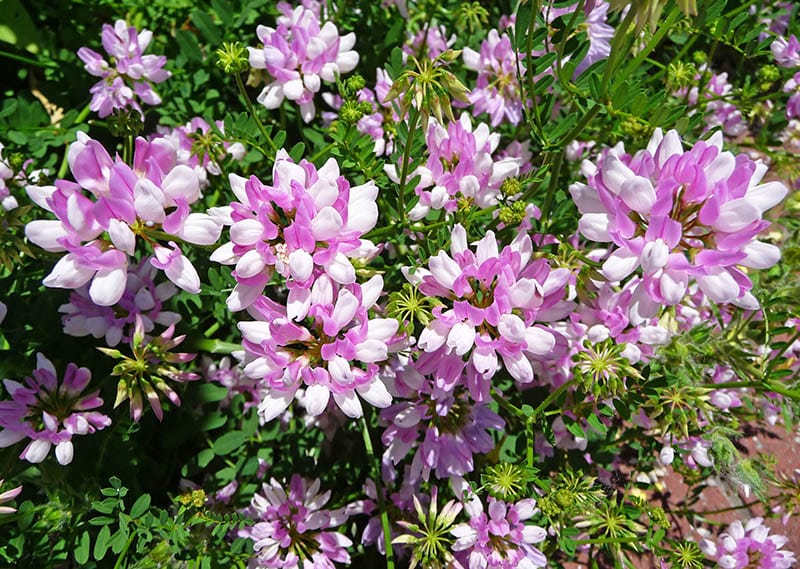
| Latin Name: | Securigera varia |
Crown vetch grows well in partial shade or full sun and reaches 2 to 3 feet in height. It is invasive and will take over an area after being introduced to provide ground cover. If planted in the garden, it can crowd out your other plants.
22. Everlasting Pea
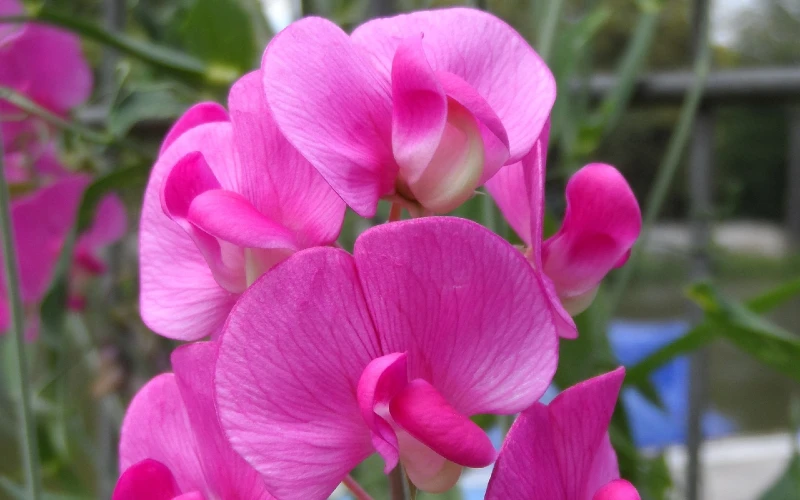
| Latin Name: | Lathyrus latifolius |
The everlasting pea can grow very tall, even reaching 10 feet tall. It grows in full or partial sun, and while it isn’t native, it was introduced in the 1700s and attracts pollinators like bees and butterflies.
23. Fireweed
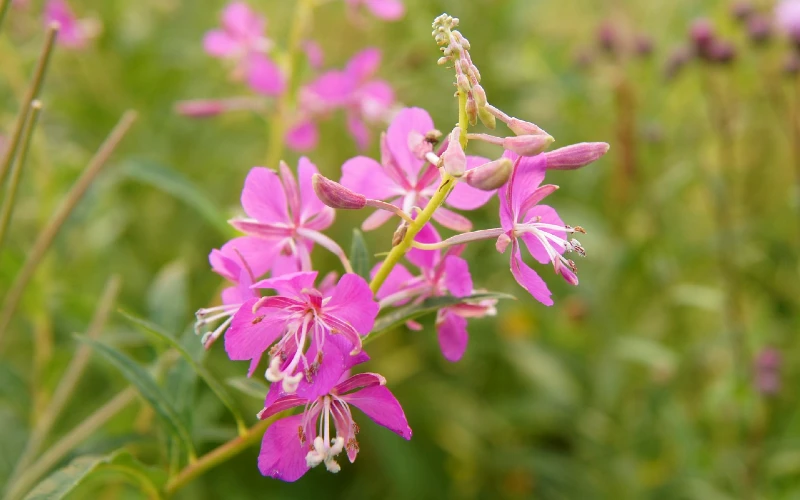
| Latin Name: | Chamerion angustifolium |
Growing to 10 feet in full sun or partial shade, fireweed is an annual or perennial. It gets its name from the fact that it is often seen to be the first to flower in areas that have been devastated by fire.
24. Joe Pye Weed

| Latin Name: | Eutrochium |
Joe Pye weed can grow in any lighting conditions and is usually found in wet or damp soil. This is a native plant, which means that it should grow well in Nebraska gardens and will benefit the local ecosystem.
25. Spreading Dogbane
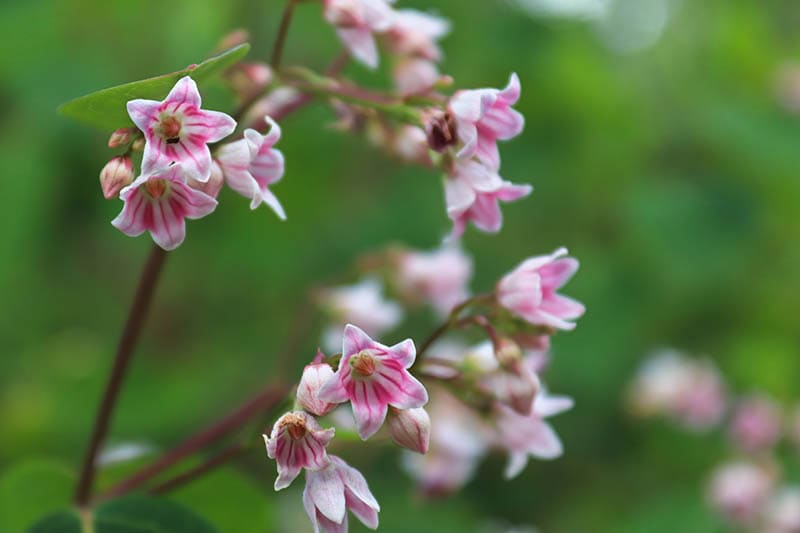
| Latin Name: | Apocynum androsaemifolium |
Spreading dogbane is a perennial that will grow in any lighting condition, from full sun to total shade. The plant’s name is related to its toxicity to dogs. It smells similar to lilac and is a prolific grower.
26. Swamp Milkweed
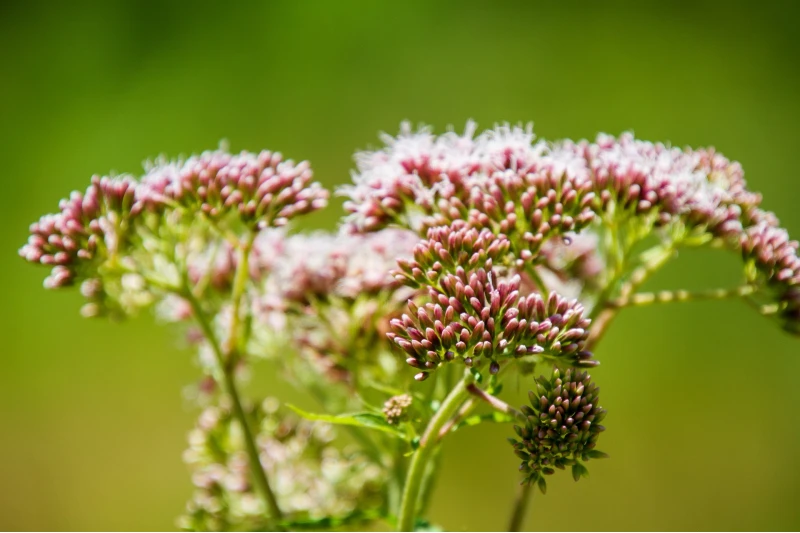
| Latin Name: | Asclepias incarnata |
Also known as pink milkweed, swamp milkweed grows in damp conditions and can be found by rivers and lakes. Swamp milkweed leaves are a popular food source for Monarch caterpillars.
27. Virginia Springbeauty

| Latin Name: | Claytonia virginica |
Springbeauty’s bright and vibrant colors make it a very popular perennial with bees. It blooms in spring and grows to 16 inches tall in full or partial sun.

Yellow Wildflowers
28. Birds-Foot Trefoil
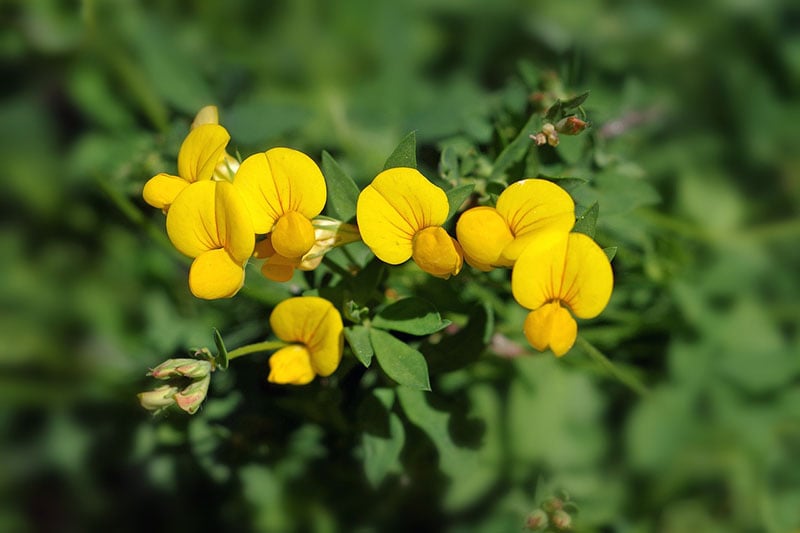
| Latin Name: | Lotus corniculatus |
Birds-foot trefoil is also known as crow toes for the shape of the yellow flowers. Sometimes the flowers can be orange or red. As vibrant as the flowers are, the plant is invasive and can overtake the area.
29. Black-Eyed Susan
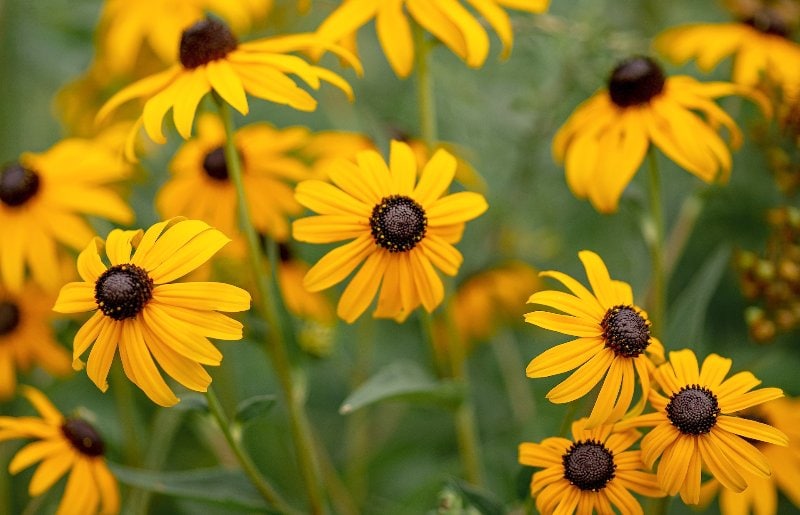
| Latin Name: | Rudbeckia hirta |
Black-eyed Susan comes in a variety of colors, from brown to yellow, and it has a black center, hence its name. It attracts a lot of birds and bees and can grow to 36 inches tall.
30. Buttercup
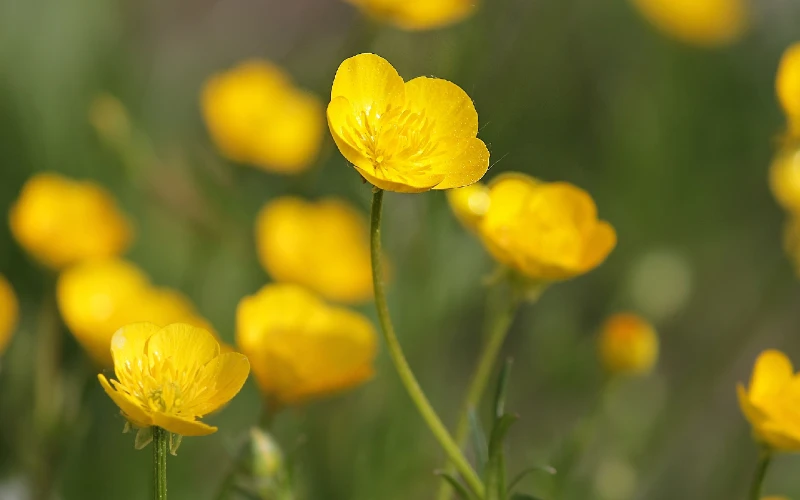
| Latin Name: | Ranunculus |
Growing to 18 inches tall, the buttercup is commonly found in moist soil and can be seen in fields, gardens, and on roadsides. It is a common wildflower, and although yellow is a common color, there are other varieties in many hues.
31. Dandelion
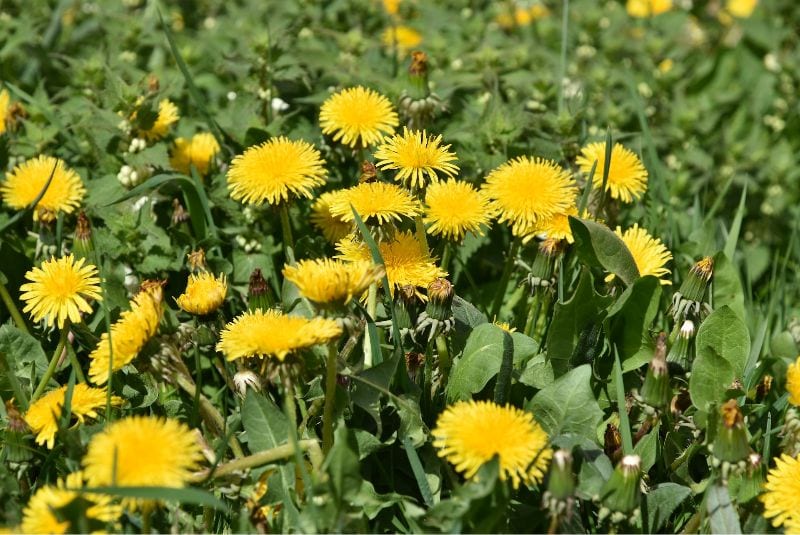
| Latin Name: | Taraxacum officinale |
Dandelions are generally considered a weed and are recognizable for their bright yellow flowers but also for their clock heads. They grow in most soil conditions, and although dandelions are not native to the U.S., they are commonly found across Nebraska.
32. Goldenrod
| Latin Name: | Solidago |
Goldenrod is a perennial that grows to heights of 5 feet. The flowers are small but bright yellow, which makes them difficult to miss. It attracts plenty of pollinators but grows quickly and spreads far.
33. Green-Headed Coneflower
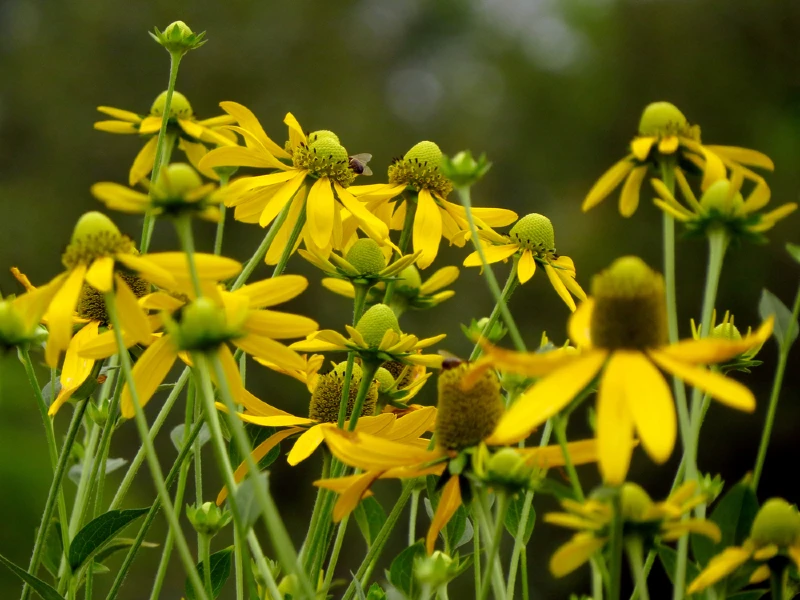
| Latin Name: | Rudbeckia laciniata |
Green-headed coneflowers have yellow petals around a green cone-shaped center. They grow in moist conditions and are found by rivers and lakes where they attract bees and other pollinators.
34. Mullein
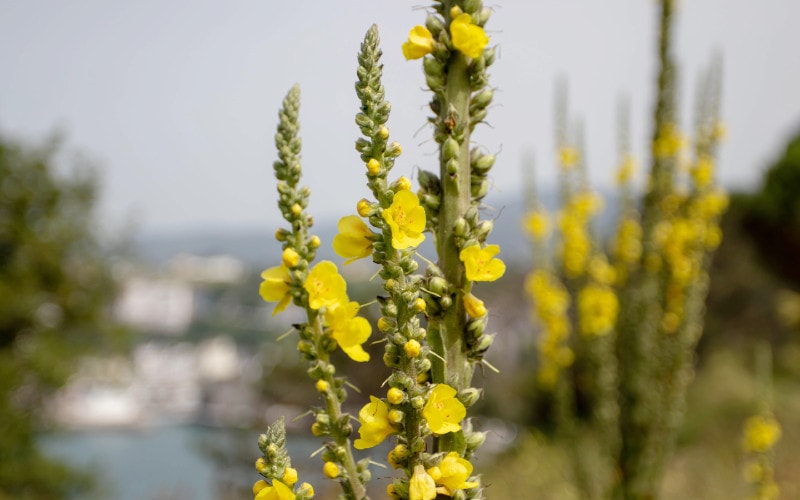
| Latin Name: | Verbascum Thapsus |
Mullein is not native to the U.S. but has become naturalized. The 7-foot-tall plant has lupin-like heads that have yellow flowers, and the plant can look a lot like fields of corn.
35. Sneezeweed

| Latin Name: | Helenium autumnale |
Also known as the false sunflower because it looks similar to the sunflower, sneezeweed also looks similar to daisies. It is found in damp environments but is also grown in gardens for its bold yellow flowers. It was previously used to make snuff.
36. Spiny Sow-Thistle
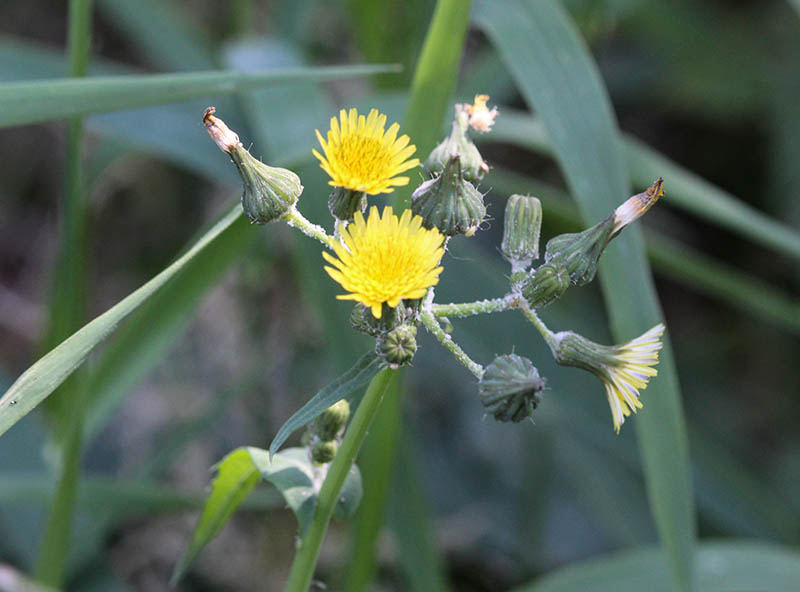
| Latin Name: | Sonchus asper |
Native to Europe and North Africa, as well as Asia, spiny sow-thistle is an invasive plant that grows across the state. It has spiky leaves and can take over an area quickly if it isn’t dealt with quickly.
37. St. John’s Wort
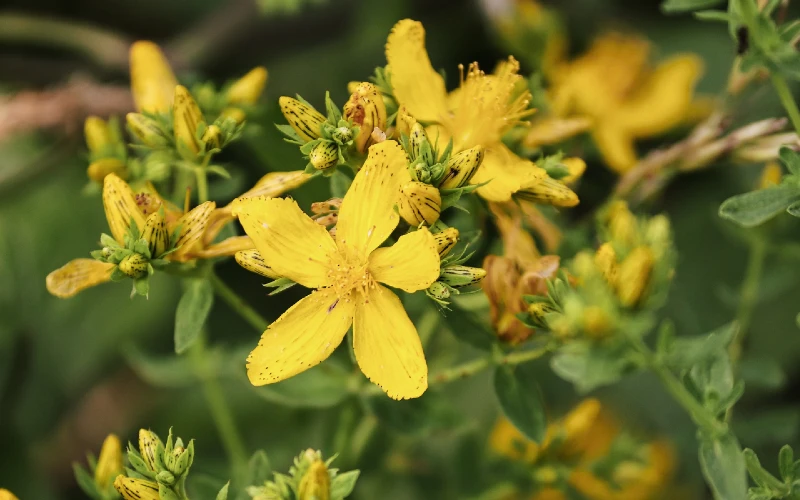
| Latin Name: | Hypericum perforatum |
Although it is considered a beneficial medicinal plant that attracts pollinators, the bright yellow St. John’s Wort can be deadly for livestock and is generally considered a weed.
38. Sunflower
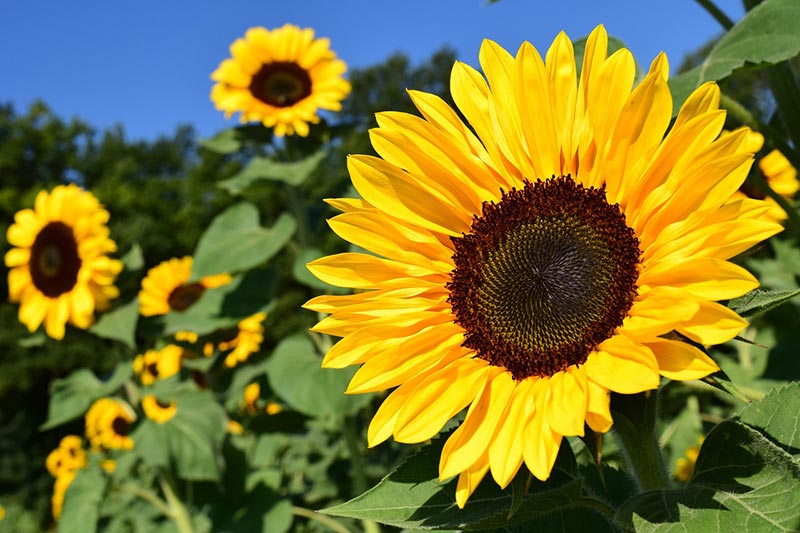
| Latin Name: | Helianthus annuus |
The sunflower is a very popular garden flower because it grows tall and has a large yellow flower on top of its stalk. The heads can grow so heavy that the stem breaks under the weight. Sunflowers can grow to 10 feet tall and are found in prairies, fields, and a host of other locations.
39. Wild Parsnip
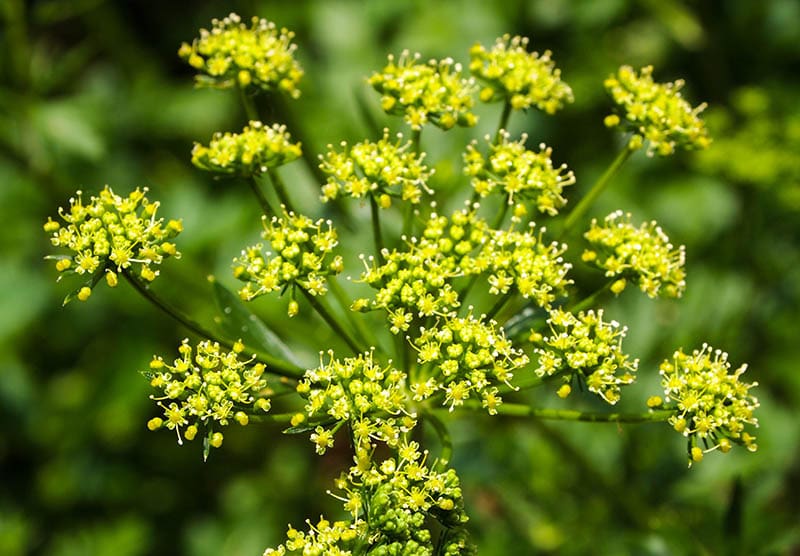
| Latin Name: | Pastinaca sativa |
The wild parsnip is a relative to the root vegetable that is eaten during the holiday season, but its wild cousin can cause serious skin irritation and should be avoided. This is another invasive species that can be seen in ditches and at the roadside.
40. Yellow Giant Hyssop

| Latin Name: | Agastache nepetoides |
The yellow giant hyssop is a perennial plant that grows to 16 inches and has a lot of small yellow flowers. It grows in full sun or partial shade and is considered deer-resistant.

White Wildflowers
41. Catnip

| Latin Name: | Nepeta cataria |
Known by cat lovers around the world for the excitable response it elicits in most cats, catnip is a member of the mint family that has culinary uses for humans, as well as medicinal properties. It is naturalized in Nebraska and grows by the road or in fields.
42. Dog Daisy
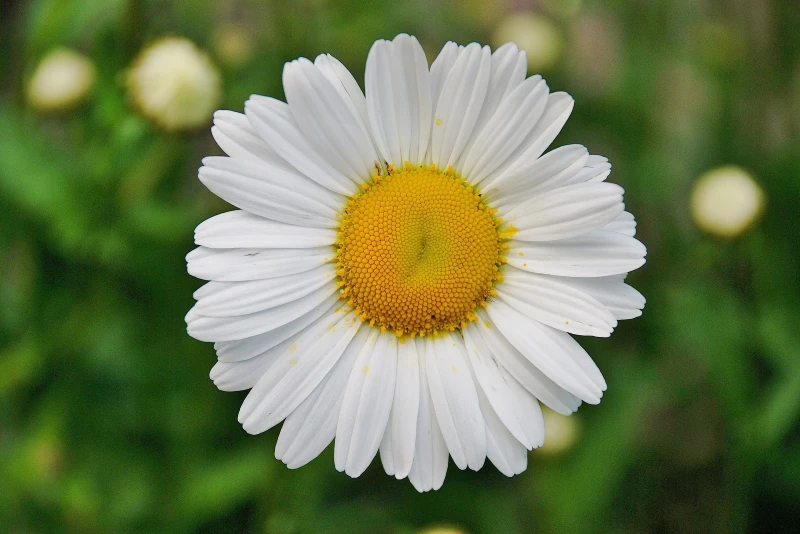
| Latin Name: | Leucanthemum vulgare |
The dog daisy is a recognizable wildflower with white petals and a bright yellow center, but the plant is not native and can spread quickly. It is seen in fields and meadows and can grow to 2 feet tall.
43. English Plantain
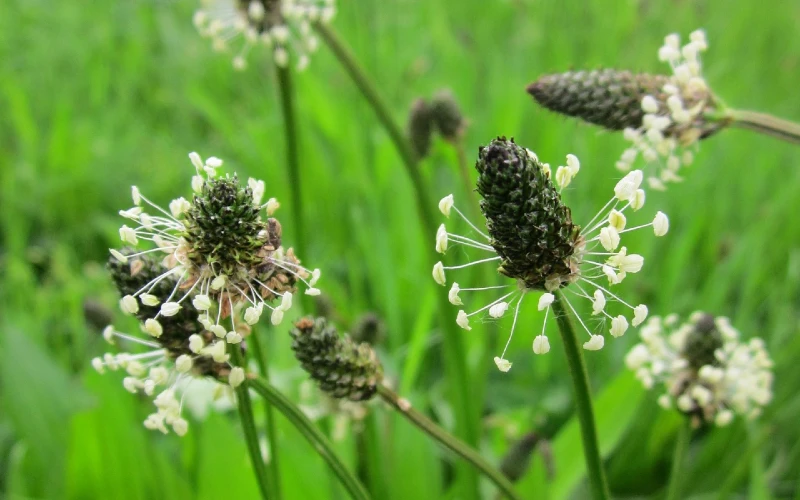
| Latin Name: | Plantago lanceolota |
English plantain is a hardy perennial plant. It is not native to the U.S. and will adapt its growth to avoid being eradicated. For example, it will grow shorter if the area it is growing in is regularly mowed.
44. Feverwort
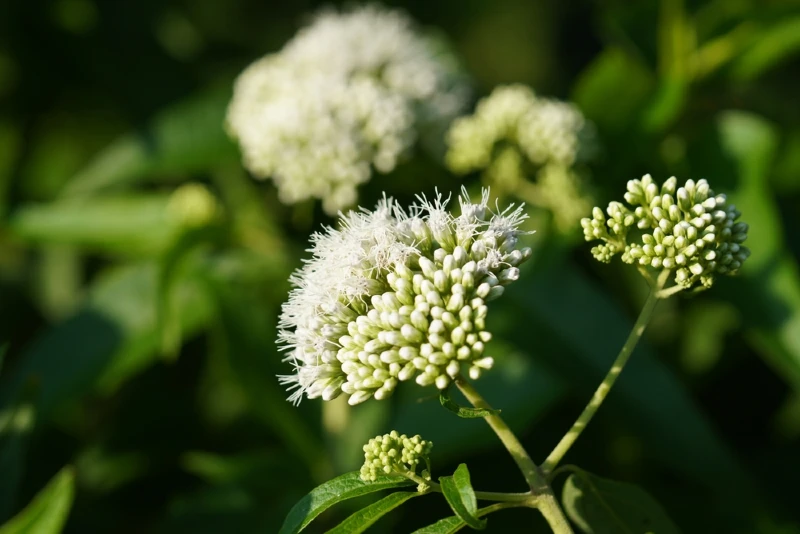
| Latin Name: | Eupatorium perfoliatum |
Boneset is an important plant for butterfly species in Nebraska, but despite having a long history of being used medicinally, it is listed as a poisonous plant and should be avoided in holistic and natural medicines.
45. Fleabane
| Latin Name: | Erigeron annuus |
The fleabane looks a lot like a daisy with thin white petals and a yellow center. It is drought resistant and will tolerate a lot of different soil conditions. The plant grows to 2 feet tall and is found near mountains and dry grass.
46. Fragrant Sand Verbena
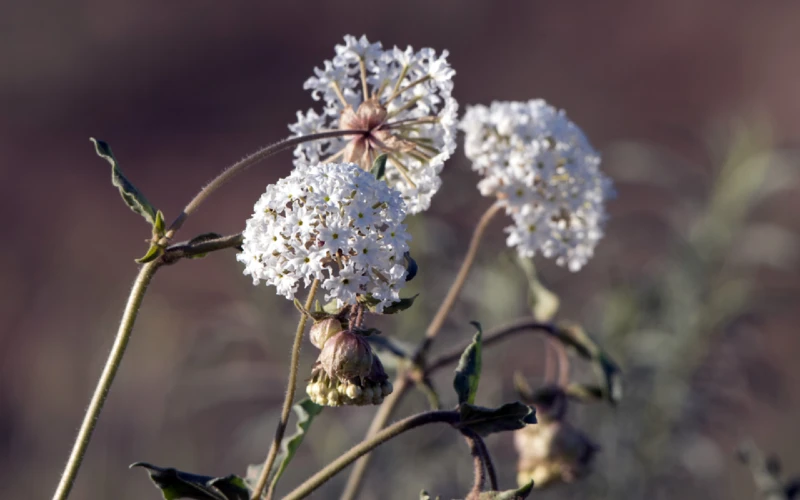
| Latin Name: | Abronia fragrans |
Fragrant sand verbena is a perennial that grows to 3 feet tall and will tolerate most soil conditions. It blooms with a ball of tiny white flowers and can be found in meadows, rocky hillsides, and mountains.
47. Indian Hemp

| Latin Name: | Apocynum cannabinum |
Indian hemp is native to North America, but it can kill crops and other plants when left to its own devices, which means that it is usually considered an aggressive weed. It grows to around 5 feet tall and can be found near farms, meadows, and prairies.
48. Meadow Anemone
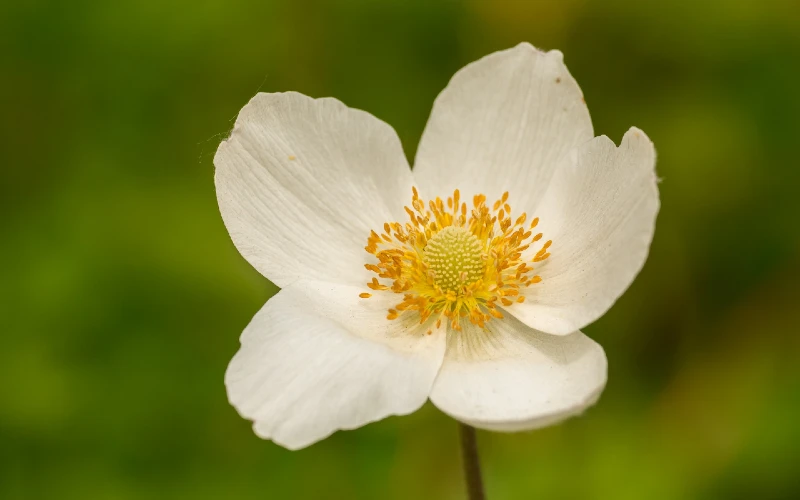
| Latin Name: | Anemone canadensis |
The meadow anemone is a perennial that produces several small flowers with five white petals and yellow stamens. It is used as ground cover for wetlands and will grow to 2 feet tall.
49. Queen Anne’s Lace
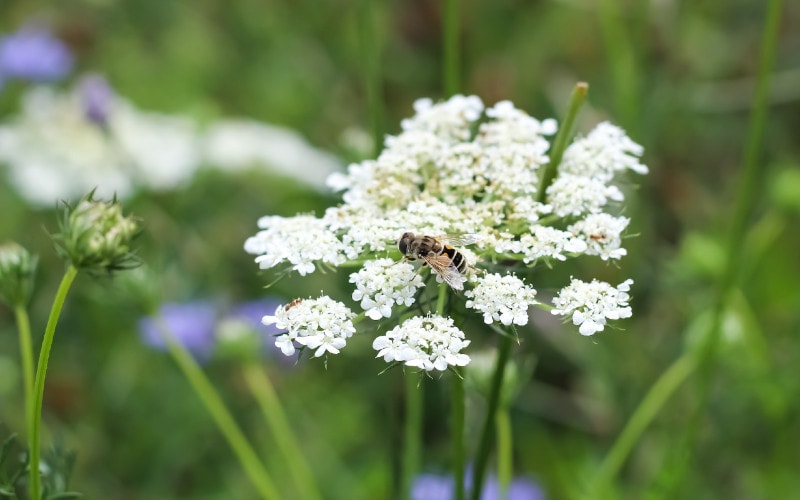
| Latin Name: | Daucus carota |
Queen Anne’s Lace has a white heather look, and its name comes from the tiny white flower heads that look like lace. It grows to 4 feet and is also known as a wild carrot. It is edible when it is young but becomes woody as it matures.
50. White Baneberry
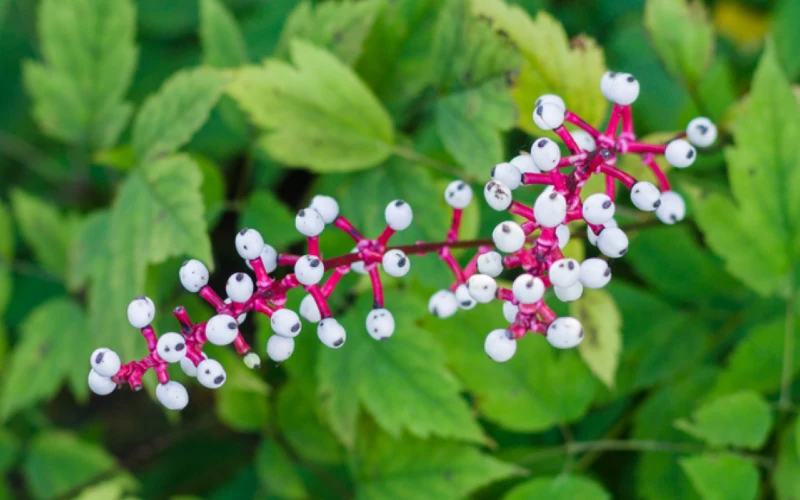
| Latin Name: | Actaea pachypoda |
Native to parts of North America, the white baneberry has small white flowers in spring, replaced by small white berries in summer. The berries are highly toxic, but this plant is native and is popular as an ornamental.
51. White Clover
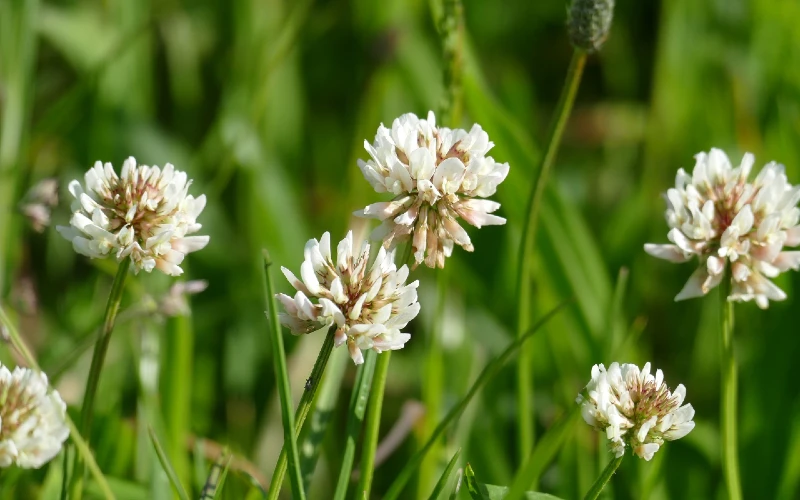
| Latin Name: | Trifolium repens |
White clover is also known as a shamrock, and the perennial wildflower will grow to 6 inches. It does well in partial shade or full sun, and although not native, it is considered a naturalized species of wildflower. It doesn’t usually kill or crowd out other plants.
52. White Snakeroot
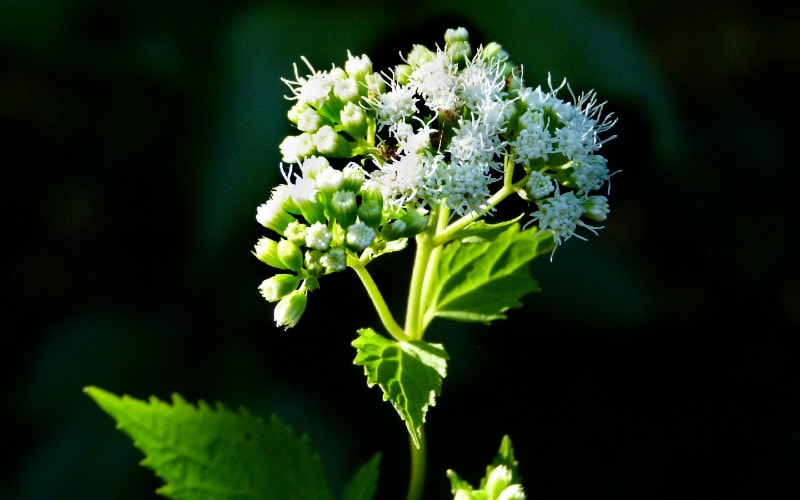
| Latin Name: | Ageratina altissima |
White snakeroot is native to North America, and it flowers late in the season, so it can bring a flash of white to otherwise dreary borders. It can grow to 5 feet and prefers moist soil over dry.
53. Whorled Milkweed
| Latin Name: | Asclepias verticillate |
Growing to 3 feet, whorled milkweed has clusters of up to 20 small white flowers and can regularly be seen in prairies and woods. The plant is native to Nebraska and is popular with pollinators.
54. Wild Mint
| Latin Name: | Mentha arvensis |
The perennial wild mint will grow to about 3 feet in height and can be found in wetlands, especially river banks and at the sides of streams. It prefers partial sunlight to full sun.
55. Yarrow
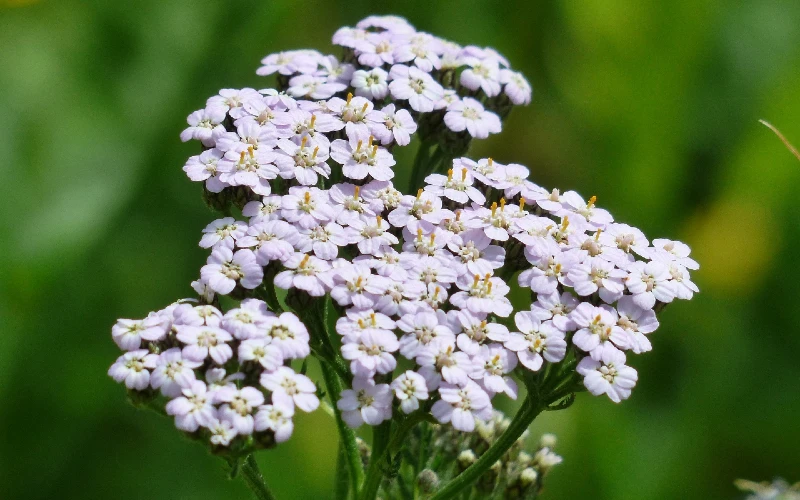
| Latin Name: | Achillea millefolium |
Yarrow plants are usually found on disturbed land, and although some species were introduced, there are also some native to the area. This combination means there are also hybridized variants.

Red Wildflowers
56. Blanket Flower
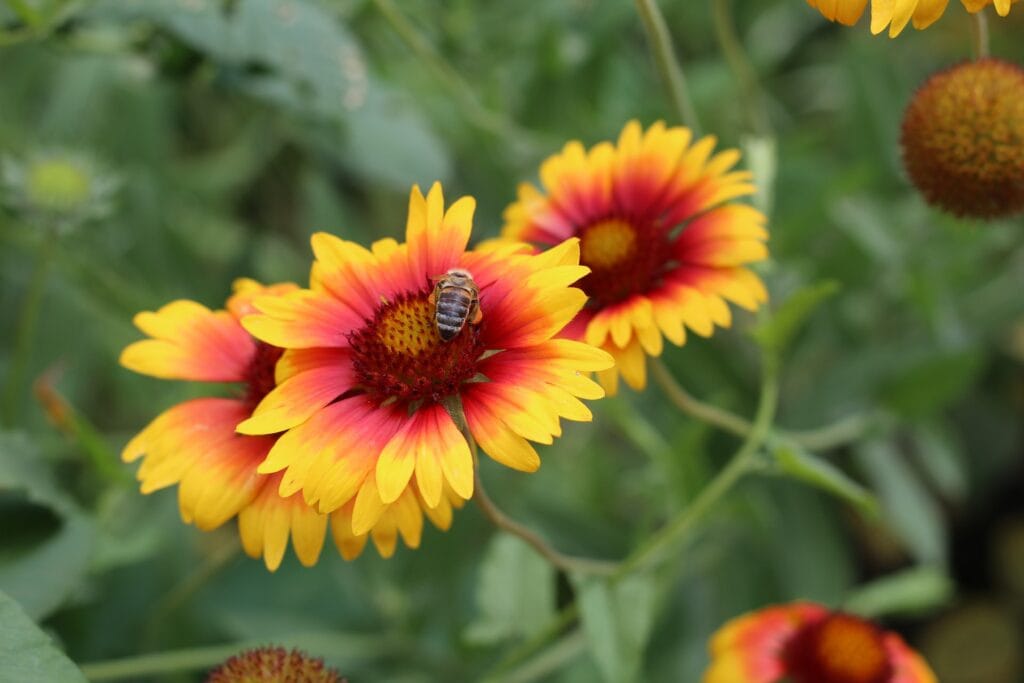
| Latin Name: | Gaillardia pulchella |
The blanket flower is a type of sunflower. It grows quite low compared to the sunflower, however, achieving a height of about 2 feet. The petals of the flowers are red towards the center with a yellow border around them, giving them a striking look. It is also used in beekeeping to produce mild honey.
57. Butterfly Weed
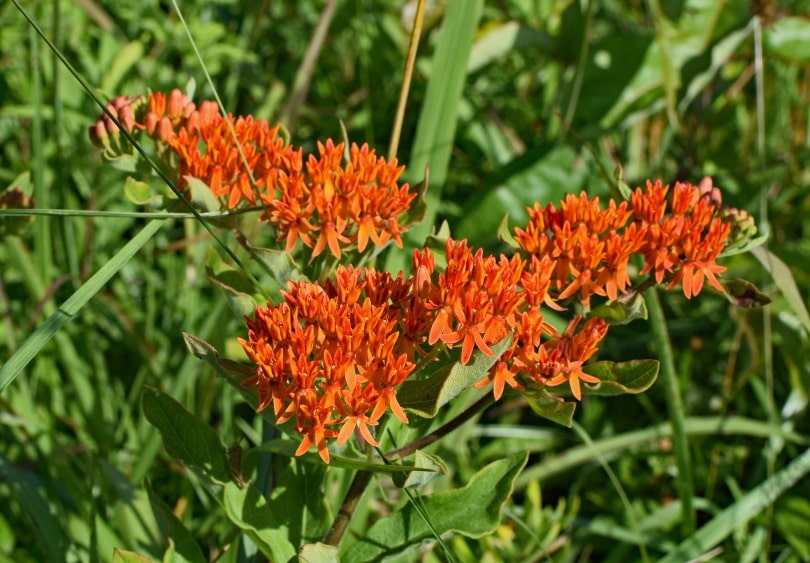
| Latin Name: | Asclepias tuberosa |
Butterfly weed produces clusters of small orange flowers and has a history of medicinal use. It is common in gardens for its bright orange color and because it attracts butterflies.
58. Cardinal Flower
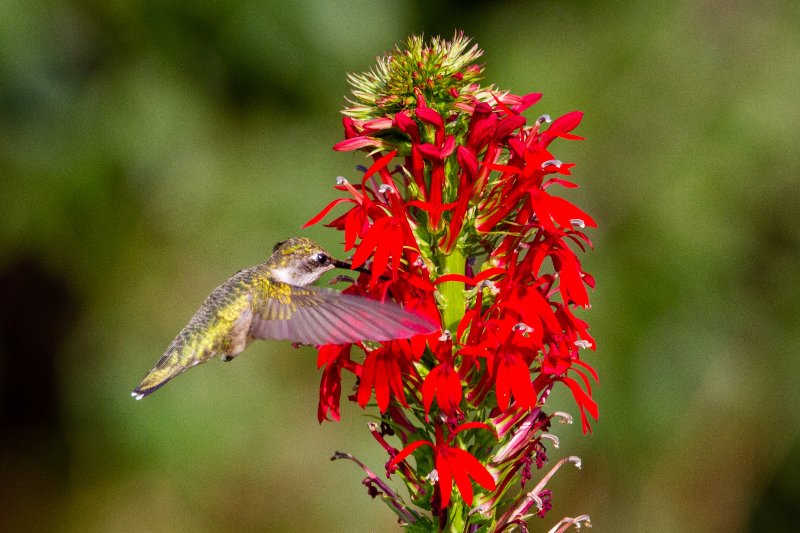
| Latin Name: | Lobelia cardinalis |
The cardinal flower has red tubular flowers, and while the nectar inside can be difficult for some birds and pollinators to reach, it is easily reached by hummingbirds. The plants grow to 6 feet and are popular in gardens.
59. Columbine
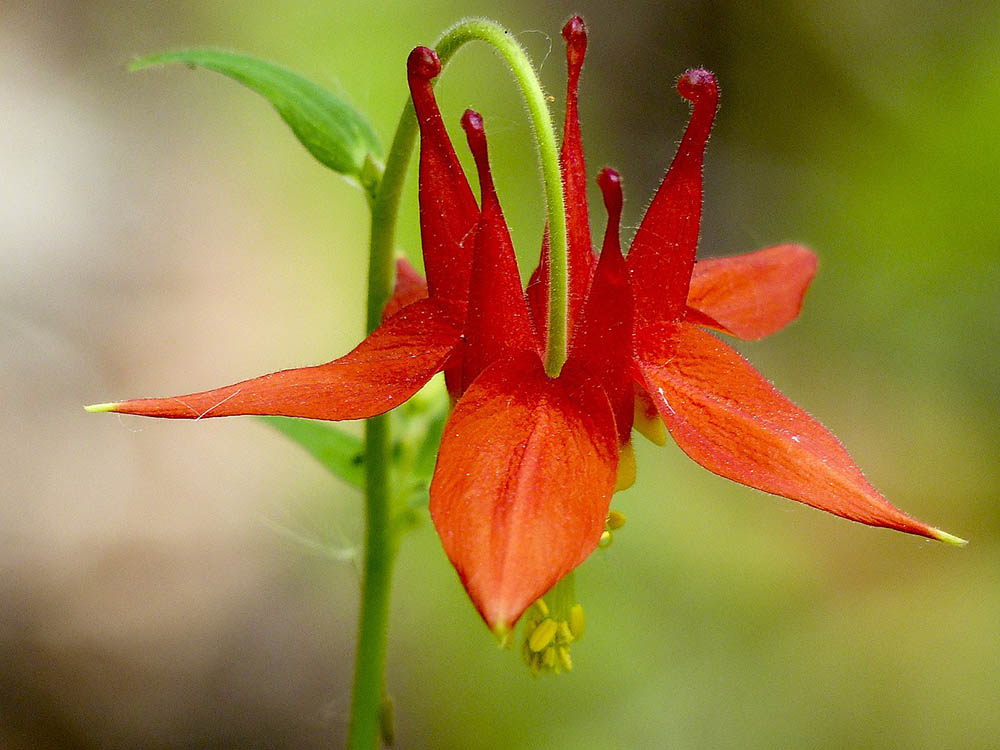
| Latin Name: | Aqualegia canadensis |
The columbine is a common, native wildflower that has red flowers that droop and are bell-shaped. The plant grows to around 4 feet and enjoys partial shade or full sun.
60. Red Baneberry
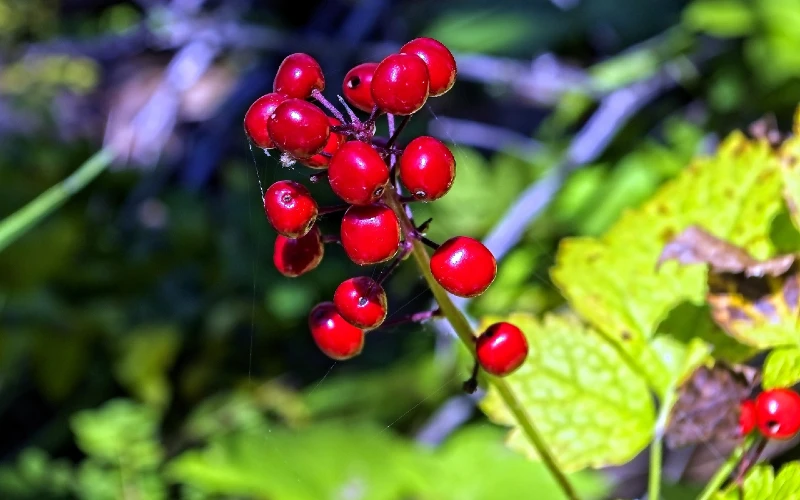
| Latin Name: | Actaea rubra |
Red baneberry is a wildflower with fluffy white flowers in the spring, but these give way to small red berries in the summer. The berries are poisonous and should not be eaten, but the plant is popular in gardens.
61. Red Lily
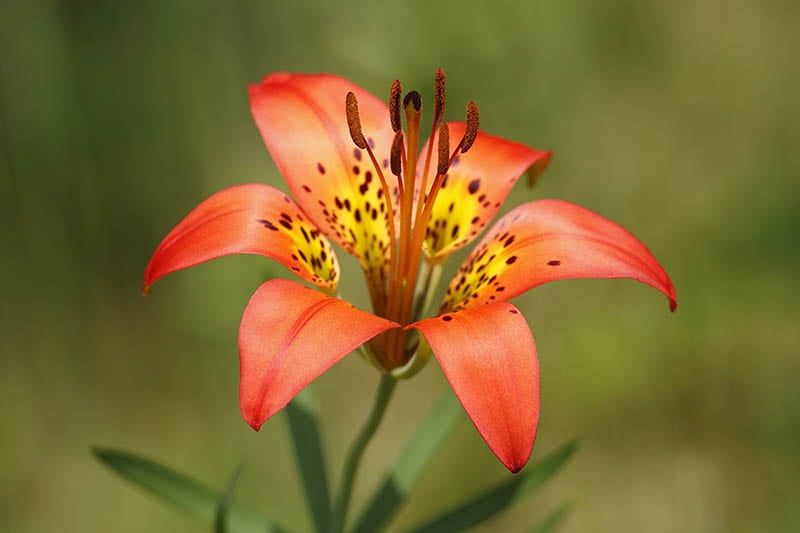
| Latin Name: | Lilium philadelphicum |
The wood lily, which is also known as the wood lily, is a member of the lily family with red flowers. It grows to around 3 feet in full or partial sun. The red lily is a good flower for those that want to attract hummingbirds and butterflies, and the lily flowers remain open for about 10 days.
62. Spotted Coralroot

| Latin Name: | Corallorhiza maculata |
The spotted coralroot is a perennial plant that grows to 2 feet. It doesn’t have any leaves, and clusters of flowers grow directly on the bare stalks. It gets nutrients from a natural fungus in its roots.
63. Spotted Touch-Me-Not
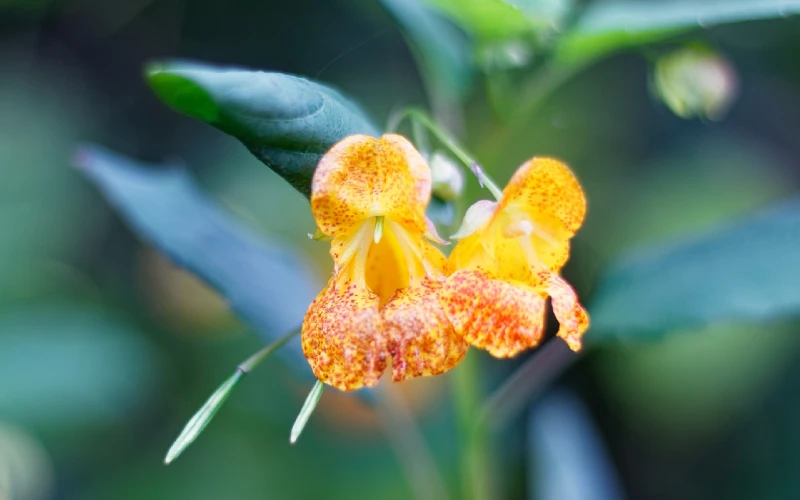
| Latin Name: | Impatiens capensis |
The spotted touch-me-not has orange flowers, and the seed heads will explode and disperse the seeds if you touch them, hence the name of the plant. Growing to a height of about 5 feet, the spotted touch-me-not is an annual that likes shade or partial sun.

Conclusion
Nebraska is home to some beautiful wildflowers, including the 63 listed above. Not all wildflowers are considered suitable or beneficial for planting in your own garden since some may be aggressive and crowd out or kill other plants in your garden. However, native plants should cope well with the weather and soil conditions in the area they are native to, which can make these a good choice for garden plants.
Featured Image Credit: Yusuf Onuk, Unsplash
Contents
